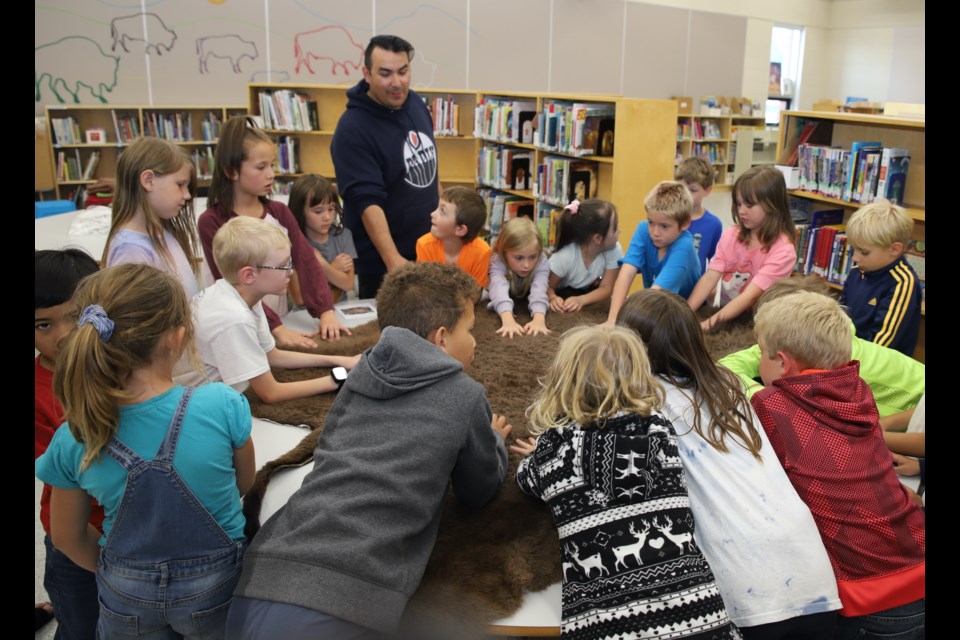OLDS — In the lead-up to June 21, National Indigenous Peoples Day, several schools in the Chinook’s Edge School Division provided opportunities for students to learn about Indigenous culture.
In École Olds Elementary School, that took the form of a visit from Cree knowledge keeper Clare Butterfly of Sylvan Lake.
The Albertan tagged along as he shared some of his knowledge with Grade 2 students.
In the school library, two tables were laden with all kinds of artifacts, including moccasins (Butterfly called them ‘moscasins’), a drum and various dried plants.
Butterfly started out by showing the kids a yellowish bag and asked them what they thought it was.
“It’s in your gut, it’s in there. This is the bladder,” he said, noting it came from a buffalo.
“This is your water bottle. This is your water carrier,” he said. “This is what you would go down to the stream with and fill this up with water and bring it back and carry it with you all day long and this is what you drink water out of.”
Although bladders store urine, Butterfly said Indigenous people carefully cleaned out the buffalo's organ, which worked well to contain water.
“By the time it’s all (scraped) out, you could use it and it would last a long time because it’s made to store that water,” he said.
Butterfly also showed the kids a bone with rough edges on it.
He explained that it was used to scrape hides so they could be used for many things, including clothing or teepees. People grabbed it upright in one hand and scraped along the hide.
“People still do this,” he said. “I know a guy who makes two of these a month because he’s going through so many hides. He’s always tanning hides. You can use metal scrapers, but he wants to do it the traditional way.”
Butterfly picked up a buffalo horn.
“Actually, don’t ever do this, but my grandmother, a long time ago, she used to talk to me about people who had head problems like headaches, migraines,” he said.
“So what you would do – this is pretty scary, but I’m going to tell you anyway – you take a sharp stone, a really sharp rock. My dad says he remembers his mom doing this to people.
“And she would cut open their head right here,” he said, pointing to the side of his head near the temple. “Just a little, not deep, not going into your head, just a little cut.
“And then she’d use a buffalo horn that had a hole in it and she’d put that horn up the side of the head and then she would suck on it to pull blood – not to eat blood, but to pull blood – to relieve some of that pressure.
“People are doing that nowadays in a different way, they use leeches. You know what leeches are? Like bloodsuckers? They put blood suckers, people do that now, rich people. Kind of an interesting way to do that – medicine,” he added.
Butterfly also showed the kids a couple of small, thin bones which he said can be found on the back of the legs of deer and buffalo.
They make very good awls – tools used to poke holes in leather or wood – and needles. He said Indigenous people would file them down just a bit with a sharp rock because those bones were already pretty sharp.
Then they would be used to stitch buffalo hide together for clothing, hides to enclose teepees, or other purposes, using sinew obtained from along the muscles of buffalo.
"This thread here, this is from the buffalo and this stuff is expensive these days. People pay big money for real sinew,” Butterfly said.
“Isn’t that amazing? There’s a needle inside that animal,” he said.
Butterfly stressed that handy as those bones are, they’re no match for the speed of a sewing machine.
“When you’re sewing hides, you use an awl to poke the hole and then you use the needle to sew the thread,” he said.
“So think about how long that would take. You have to poke a hole, sew it, poke a hole, sew it, poke a hole, sew it. A lot more work. In the old days, women would have to make those teepees just by hand.”
He pointed out before they were able to sew the hides, Indigenous people had to scrape all the hair and fat off the hides, which was equally time consuming.
Butterfly said 15 buffalo hides might be needed for a teepee.
“I mean, it takes a lot of work to live the way my people used to live.”
Butterfly and teacher Sylvia Martens explained that Indigenous people also used many plants, not only for food but also for medicines.
Butterfly had another surprise for the students.
He held up a chunk of muskeg and asked them what it was used for.
"This is diapers, guys,” he said, spurring some giggles from the students.
“And it’s much better than the diapers you guys wore when you were babies; much better, because you don’t get rashes, you don’t get infections,” Butterfly added.
“This actually is medicine in your diaper, so it’s also good for really bad cuts. If you have a really bad cut, put that moss right on to your cut and then wrap it up and it’ll heal your cut up really quickly.”
He held up a pair of moccasins.
“You put buffalo fur inside there, then you put your feet in there and then it warms them, like big, warm socks inside there.”
But the most popular display was a big furry buffalo hide spread across a table. All the kids gathered around it and ran their fingers through the fur.



